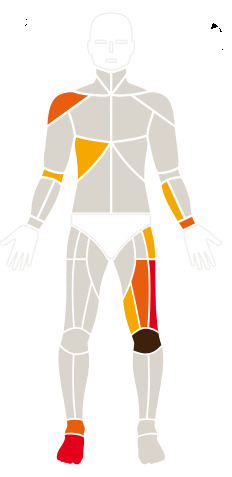
+
+
+
Enter Thermography:
A Non-Invasive Approach to Pain Management Thermography, a non-invasive imaging technique that detects infrared radiation emitted from the body’s surface, presents an innovative approach to pain management, especially for nerve-related discomfort. Through visualization of thermal patterns associated with altered blood flow, inflammation, and neural dysfunction, thermography provides crucial insights into the underlying mechanisms of pain perception, enabling targeted interventions and improved treatment outcomes.
How Thermography Works in Nerve Pain Management: Thermography functions on the principle that changes in skin temperature correlate with underlying physiological processes, including inflammation, vascular perfusion, and neural activity. In nerve pain management, thermographic imaging can identify localized temperature asymmetries along affected nerve pathways, indicating neural hypersensitivity or dysfunction. Through precise mapping of these thermal signatures, healthcare providers can pinpoint pain sources, evaluate severity, and track treatment progress over time.
Benefits of Thermography in Pain Management:
- Early Detection and Intervention: One of the primary advantages of thermography in nerve pain management is its ability to detect subtle thermal abnormalities before symptoms escalate. By capturing thermal signatures indicative of nerve compression, entrapment, or inflammation, thermography enables early intervention, potentially preventing progression to chronic pain states.
- Objective Assessment of Pain: Unlike traditional pain assessment methods reliant on subjective reporting, thermography offers an objective, quantifiable measure of pain intensity and distribution. By correlating thermal patterns with clinical symptoms, healthcare providers can gauge the severity of nerve-related discomfort and tailor treatment strategies accordingly.
- Personalized Treatment Planning: Thermography empowers healthcare providers to develop personalized treatment plans based on individual pain profiles and underlying pathophysiology. By identifying areas of thermal asymmetry or hyperthermia along specific nerve pathways, they can target interventions such as nerve blocks, physical therapy modalities, or pharmacological agents with precision, maximizing therapeutic efficacy and minimizing side effects.
- Monitoring Treatment Response: Thermographic imaging serves as a valuable tool for monitoring treatment response and adjusting therapeutic interventions in real time. By tracking changes in thermal patterns following interventions such as nerve blocks or medication adjustments, healthcare providers can assess the effectiveness of treatment modalities and make informed decisions regarding ongoing pain management strategies.
- Non-Invasive and Radiation-Free: Unlike conventional imaging modalities such as X-rays or MRIs, thermography is non-invasive, radiation-free, and devoid of any known adverse effects. This makes it particularly well-suited for individuals with contraindications to ionizing radiation or those seeking non-pharmacological alternatives for pain management.
- 1.Early Detection and Intervention: One of the primary advantages of thermography in nerve pain management is its ability to detect subtle thermal abnormalities before symptoms escalate. By capturing thermal signatures indicative of nerve compression, entrapment, or inflammation, thermography enables early intervention, potentially preventing progression to chronic pain states.
- 2.Objective Assessment of Pain: Unlike traditional pain assessment methods reliant on subjective reporting, thermography offers an objective, quantifiable measure of pain intensity and distribution. By correlating thermal patterns with clinical symptoms, healthcare providers can gauge the severity of nerve-related discomfort and tailor treatment strategies accordingly.
- 3.Personalized Treatment Planning: Thermography empowers healthcare providers to develop personalized treatment plans based on individual pain profiles and underlying pathophysiology. By identifying areas of thermal asymmetry or hyperthermia along specific nerve pathways, they can target interventions such as nerve blocks, physical therapy modalities, or pharmacological agents with precision, maximizing therapeutic efficacy and minimizing side effects.
- 4.Monitoring Treatment Response: Thermographic imaging serves as a valuable tool for monitoring treatment response and adjusting therapeutic interventions in real time. By tracking changes in thermal patterns following interventions such as nerve blocks or medication adjustments, healthcare providers can assess the effectiveness of treatment modalities and make informed decisions regarding ongoing pain management strategies.
- 5.Non-Invasive and Radiation-Free: Unlike conventional imaging modalities such as X-rays or MRIs, thermography is non-invasive, radiation-free, and devoid of any known adverse effects. This makes it particularly well-suited for individuals with contraindications to ionizing radiation or those seeking non-pharmacological alternatives for pain management.
Empowering Individuals to Take Control of Their Pain:
In Denmark, where the changing seasons bring varying challenges to pain management, thermography emerges as a beacon of hope for individuals grappling with nerve-related pain. By utilizing advanced infrared technology to visualize thermal signatures indicative of neural dysfunction, thermography offers a comprehensive approach to pain management, empowering individuals to take control of their pain and reclaim their lives.
Nerve pain can be a formidable adversary, impacting every facet of daily life and diminishing overall well-being. In the quest for effective pain management strategies, Danish residents are increasingly embracing innovative approaches like thermography to better manage their pain and regain control of their lives. By offering a non-invasive, objective assessment of thermal patterns associated with nerve-related discomfort, thermography shows great promise as a valuable tool in the multidisciplinary approach to pain management, ushering in a new era of personalized, targeted therapies tailored to individual pain profiles.
